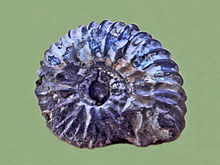| This article needs attention from an expert in Palaeontology. The specific problem is: Asking if correct to add Gastrohoplites article under Gastroplitinae subfamily?. WikiProject Palaeontology may be able to help recruit an expert. (December 2023) |
| Hoplitidae Temporal range: Aptian–Cenomanian PreꞒ Ꞓ O S D C P T J K Pg N | |
|---|---|

| |
| Fossil of Sonneratia dutempleana from France, on display at Galerie de paléontologie et d'anatomie comparée in Paris | |
| Scientific classification | |
| Domain: | Eukaryota |
| Kingdom: | Animalia |
| Phylum: | Mollusca |
| Class: | Cephalopoda |
| Subclass: | †Ammonoidea |
| Order: | †Ammonitida |
| Superfamily: | †Hoplitoidea |
| Family: | †Hoplitidae Douvillé, 1890 |
The Hoplitidae is a family of Cretaceous ammonites that lived during the middle of the period from the late Aptian to the Cenomanian. They are part of the superfamily Hoplitoidea.
Members of the Hoplitidae are typically evolute, with inner whorls exposed, although some are more involute, and are commonly stout and strongly ribbed, with pronounced tubercles.
The Hoplitidae are thought to be derived from the U Aptian -M Albian Uligella of the Desmoceratidae, or some related form and have been divided into three subfamilies.
Subtaxa
Classification of Hoplitidae was revised multiple times during the last few decades. Currently, Hoplitidae contains 3 subfamilies:
- Gastroplitinae
- Sonneratiinae
- Hoplitinae
- Otohoplites
- Hoplites
- Hoplites (Hoplites)
- Hoplites (Isohoplites)
- Anahoplites
- Dimorphoplites
- Epihoplites
- Epihoplites (Metaclavites)
- Epihoplites (Epihoplites)
- Semenoviceras
- Callihoplites
- Pleurohoplites
- Pleurohoplites (Pleurohoplites)
- Pleurohoplites (Arrhaphoceras)
- Euhoplites
- Hyphoplites
- Hyphoplites (Hyphoplites)
- Hyphoplites (Discohoplites)
Phylogenetic relations
The Hoplitidae may have given rise to the Schloenbachiidae and seems to be in a different branch of the Hoplitoidea from earlier families included.
References
- Amédro, F., Matrion, B., Magniez-Jannin, F., & Touch, R. (2014). La limite Albien inférieur-Albien moyen dans l’Albien type de l’Aube (France): ammonites, foraminifères, séquences. Revue de Paléobiologie, 33(1), 159-279.
- Treatise on Invertebrate Paleontology, Part L, Mollusca 4, Mesozoic Ammonoidea. R.C. Moore (ed). Geological Soc. of America and Univ Kansas Press (1957)
- Hoplitidae-Paleodb
| Taxon identifiers | |
|---|---|
| Hoplitidae | |
This Ammonitina-related article is a stub. You can help Misplaced Pages by expanding it. |